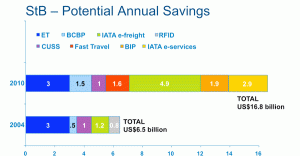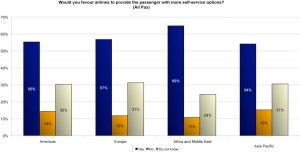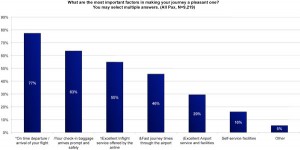Are you ready to simplify your business?
- Like
- Digg
- Del
- Tumblr
- VKontakte
- Buffer
- Love This
- Odnoklassniki
- Meneame
- Blogger
- Amazon
- Yahoo Mail
- Gmail
- AOL
- Newsvine
- HackerNews
- Evernote
- MySpace
- Mail.ru
- Viadeo
- Line
- Comments
- Yummly
- SMS
- Viber
- Telegram
- Subscribe
- Skype
- Facebook Messenger
- Kakao
- LiveJournal
- Yammer
- Edgar
- Fintel
- Mix
- Instapaper
- Copy Link
Posted: 5 April 2010 | Philippe Bruyère, Global Head, Passenger Division, IATA | No comments yet
Losses continue. Routes are being cut. Industry numbers are down. Passengers are demanding better service. The industry needs new ways of delivering services that fundamentally change its cost base but also improve customer convenience.
Enter IATA’s Simplifying the Business (StB) programme. StB began in 2004. Its mission is to change the way the industry operates – resulting in better service for passengers and lower costs for the industry. Since its founding, the programme has delivered US$4 billion in annual industry savings through the successful completion of two projects. The industry transitioned to 100% e-ticketing in June 2008, generating US$3 billion in savings. A further US$1 billion was saved by the completion of the common use self-service (CUSS) kiosk project in December 2008. That project focused on the implementation of CUSS kiosks at airports around the world in order to provide additional check-in capacity and added convenience.
Losses continue. Routes are being cut. Industry numbers are down. Passengers are demanding better service. The industry needs new ways of delivering services that fundamentally change its cost base but also improve customer convenience.
Enter IATA’s Simplifying the Business (StB) programme. StB began in 2004. Its mission is to change the way the industry operates – resulting in better service for passengers and lower costs for the industry. Since its founding, the programme has delivered US$4 billion in annual industry savings through the successful completion of two projects. The industry transitioned to 100% e-ticketing in June 2008, generating US$3 billion in savings. A further US$1 billion was saved by the completion of the common use self-service (CUSS) kiosk project in December 2008. That project focused on the implementation of CUSS kiosks at airports around the world in order to provide additional check-in capacity and added convenience.
Today, we find ourselves in the midst of yet another crisis, and recovery looks uncertain. By working together, the air transport industry will be able to produce long-lasting change that will allow it to succeed in today’s business environment. StB’s change agenda can save the industry up to US$16.8 billion a year. Are airports ready?
Moving towards e-travel
An e-travel vision – where airlines no longer issue any paper documents to passengers – guides several StB initiatives.
E-ticketing, eliminating paper tickets, was the first step towards e-travel. Removing paper tickets in 2008 led to the introduction of electronic boarding passes, part of StB’s bar coded boarding pass (BCBP) project. Mobile phone boarding passes have proven extremely popular with passengers and airlines alike. Over 20 airlines now issue mobile BCBPs, where passengers receive IATA standard 2D barcodes on their mobile phones. They can then present their phone at security, the boarding gate and when they enter the plane. Security checkpoints at airports have transitioned smoothly to acceptance of mobile BCBP – in fact, these electronic boarding passes offer better security than their magnetic stripe equivalents, as security officials can scan the barcodes to verify their authenticity. The IATA standard for mobile BCBP was adopted by the Joint Passenger Services Conference in October 2007 and published in June 2008.
StB’s BCBP project aims to substitute magnetic-stripe boarding passes with those that use an IATA 2D barcode standard. The IATA Board has issued a mandate for the industry to be 100% BCBP (on a mobile phone, at a kiosk or at a check-in desk) by the end of 2010. There are three areas where airports need to take action in order to accept and fully benefit from bar coded boarding passes:
- Put the right equipment in place
The check-in and boarding equipment at airports needs to support 2D barcodes. Airports that own this equipment need to upgrade to ensure it is compatible with 2D barcodes.
In cases where suppliers and ground handlers provide this equipment, airports should coordinate with these parties to ensure they can accept and process bar coded boarding passes. - Train people who are processing passengers
With BCBP, passengers are able to check-in and print their boarding pass before they arrive at the airport. Airport employees, particularly in the security and duty free areas, must be familiar with these boarding passes in order to accept passengers with BCBP. If airports outsource these services to third parties, they should coordinate with those third parties to ensure that passengers with bar coded boarding passes will have an uninterrupted journey through the airport. - Use capacity effectively
Because passengers can check-in before coming to the airport, airports who are 100% BCBP have more flexibility to use space according to their specific requirements. For example, some check-in desks can be converted into bag-drop facilities, allowing passengers who already have their boarding pass to quickly deposit their luggage. This will allow airports to process more flights, or use space for other revenue- generating purposes.
IATA, in cooperation with Airports Council International (ACI), is committed to helping airports meet the 100% BCBP mandate. The association has established the BCBP Match maker, a free of-charge, secure website that allows airlines and airports to work together to achieve 100% BCBP. Today, nearly 700 airports are using this tool and communicating with their partner airlines to coordinate the move to 2D boarding passes. It is critical for airports to register and input their BCBP status so they can exchange messages with airlines and plan the move to 100% BCBP together. The matchmaker is available at http://www.iata.org/stb/bcbp/Matchmaking.htm
For more information on BCBP…
- Visit BCBP’s dedicated web page for airports: http://www.iata.org/stb/bcbp/airport.htm
- Airports can track the progress of BCBP around the world via an interactive map, available on the IATA website at: http://www.iata.org/stb/maps/bcbp.html.
Now that e-tickets and e-boarding passes are in circulation, the last step is the removal of paper miscellaneous documents. These documents will be replaced with electronic versions using IATA’s Electronic Miscellaneous Document (EMD) standard. The IATA e-services project, approved by the IATA Board in December 2009, will drive implementation of the EMD standard across the industry, completing the final step in the road to e-travel.
Paper documents, like excess baggage tickets, tour orders, and prepaid ticket advices, still stand in the way of a smooth, seamless and paperless experience for passengers. Airline proprietary electronic versions of these documents don’t provide the flexibility interline passengers need.
The IATA board set a target of 100% industry capability by the end of 2012, and 100% usage of EMDs in IATA distribution systems by the end of 2013.
IATA e-services represents US$2.9 billion in annual savings for the industry – increasing the total StB annual value proposition to US$16.9 billion upon implementation.


Graph 1
Putting passengers in control:
Fast Travel
According to the 2009 IATA Corporate Air Travel Survey (CATS), over half of all passengers surveyed want airlines to provide them with more self-service options (see Graph 2).
There are five Fast Travel areas moving forward in 2010:
- Bags ready-to-go: enabling passengers to deliver their bags tagged and ready for acceptance by an airline check-in agent, speeding up the check-in process for those passengers travelling with baggage
- Document check: allowing passengers to scan their travel documents at kiosks for on ward transmission to government agencies and transmitting this information for verification by arriving government authorities
- Flight re-booking: allowing passengers to rebook their flights using kiosks in case of irregular operations, avoiding long lines
- Self-boarding: providing an automated boarding process for passengers, like in a train or metro station, reducing boarding lines
- Bag recovery: allowing passengers to report a missing bag through a self-service channel instead of waiting in line at a baggage service counter.


Graph 2
Airports: Gain a competitive edge
Fast Travel projects are implemented on the ground, not in the air. Airports are therefore at the forefront of the programme.
Kuala Lumpur International Airport (KLIA) is a leading proponent of Fast Travel. The airport offers document scanning at its CUSS kiosks and self-boarding for Malaysia Airlines domestic flights.
Montreal’s Pierre Trudeau International Airport is another active participant in the Fast Travel working group and an early adopter of the programme. Bags ready-to-go and document scanning are services already offered at YUL, with more self-service initiatives planned.


Graph 3
Now, improving the end-to-end passenger experience
What’s the point of reducing one passenger queue if it just means lengthening another?
A new Passenger Experience Management Group (PEMG) was created in October 2009. The group will focus on improving passenger movement throughout their journey, from check-in to security to baggage claim. The new group looks at developing standards and recommended practices for the end-to-end passenger process. The first meeting of the group was held in February 2010. Over 100 attendees from across the industry were present, making the inaugural meeting a great success.
We now have a one-stop shop for IATA and industry efforts to improve the passenger experience – from check-in to security to boarding.
Four working groups report to the PEMG – Fast Travel Working Group, Common Use Working Group, BCBP Working Group and Passenger Facilitation Working Group. PEMG reports to the Passenger Services Conference, the main IATA standard setting body.
Government authorities control certain aspects – such as security and immigration – where the industry’s influence is admittedly limited. But that doesn’t deter the group from achieving its vision of providing the passenger with more choice, convenience and control.
The focus now is on developing recommended practices for those areas controlled by government authorities. By offering solutions that address the entire passenger experience, our hope is to make significant steps towards an easier, better way to travel.
For more information on Fast Travel…
- Visit the Fast Travel website, www.iata.org/fast-travel, to find out the latest on the programme and to download Fast Travel data
- Join the Fast Travel working group. This group is creating the self-service standards that will change the way the industry delivers services to passengers. To join, send an email indicating your interest to [email protected].
Taking aim at mishandling: IATA targets a 50% reduction in mishandled bags by 2012
Although airlines get baggage right 98% of the time, mishandling costs the industry over US$3 billion every year.
Baggage is also a big issue for customers. Mishandled baggage is among the top two concerns for travellers according to the 2009 IATA Corporate Air Travel Survey (CATS) – a survey of travellers conducted worldwide (see Graph 3).
IATA’s solution: the Baggage Improvement Programme (BIP)
Given the unprecedented economic times, how can the industry address this drain on its finances and improve service at the same time? One answer is IATA’s Baggage Improvement Program (BIP). It proposes mishandling solutions to airlines and airports around the world that, when implemented, could cut mishandling in half by the end of 2012 – saving the industry US$1.9 billion a year.
BIP targets the 200 airports that feature in 85% of all passenger mishandling claims. The top 80 airports, and the airlines that serve them, will receive free dedicated consulting services from IATA’s BIP team. In 2009, the team visited 25 airports that are mentioned in 28% of the mishandling files. During those visits, BIP solutions addressed on average over 90% mishandling, bringing value to an industry in crisis and creating big industry supporters of the programme. One example is TAM at Sao Paulo Airport, where mishandling was cut in half.
The remaining 120 airports will become part of a self-help programme that will feature workshops and a solutions toolkit. The self-help programme begins in 2010.
Will you work with me?
The first step towards a diagnosis visit is to gain commitment from airlines and airports to participate in BIP. This programme, like any other IATA Simplifying the Business initiative, is based on a collaborative industry approach that results in mutually beneficial outcomes for everyone.
Part of the BIP programme involves getting to know the airline’s baggage environment and concerns. This is learnt during a focus session, that the BIP team then use to ensure that the diagnosis and solutions chosen are appropriate to the culture of the airline. This is the first step that is undertaken once commitment is gained and the airline is on-board.
BIP then conducts an airport diagnosis visit, where the team’s baggage experts identify and recommend solutions that address mishandling. The BIP diagnosis visit is thorough. It involves a five-day visit to the airport, coordinated by the lead airline. The visit is timed to meet the peaks of the operation, so there are early starts and late finishes as needed to observe the airline schedule. Once the team gets a first-hand look at the problem areas, they can then see what solutions will address the issues that have been identified. This is captured in the BIP diagnosis report, a 30 – 70 page document that describes a generic baggage process in terms of the actual operation. Once the report is delivered, the team sits down with the lead airline and the airport to agree on a way forward, so that these solutions can be implemented and the participants can see tangible cost savings and improvements in service.
More information about BIP is available at www.iata.org/bip.
StB & Airports The industry cannot afford to stand still. To survive, we must simplify the travel experience – by eliminating paper and introducing self-service where it makes commercial sense to do so. These two elements – e-travel and Fast Travel – make up Simplifying the Business.
Airports are critical stakeholders. For e-travel, they are instrumental in the implementation of paperless infrastructure, like barcode scanners at security checkpoints and check-in desks. Paperless infrastructure, such as the mobile boarding pass, can also create competitive advantages in service as airports compete for the discerning business traveller.
For Fast Travel, airports are instrumental in the implementation of common use self-service infrastructure. Airports also stand to benefit a great deal from this infrastructure, as passenger processing can be increased without multi-million dollar development projects.
For more information on the programme and to keep up-to-date with progress in 2010, visit www.iata.org/stb.
About the author
Philippe Bruyère has 17 years of experience in the finance and aviation industries. He is currently the Global Head of IATA’s Passenger division, which includes the following areas:
- Airport Operations
- Inflight Services
- Management of IATA Billing and Settlement Plans (BSPs)
- Passenger Interline Standards
- Scheduling
- Simplifying the Business
- Travel Agency Policies.
In this capacity, Mr. Bruyère leads a global team of over 200 people in more than 80 countries. He was instrumentally involved in the 2008 industry-wide transition to electronic ticketing, eliminating paper tickets and saving the industry US$3 billion every year.
Mr. Bruyère joined IATA in September 2003 as Director, Industry Financial Services, and remained in this post for 18 months before becoming Programme Director, Simplifying the Business. He assumed his current position in May 2009.
Prior to joining IATA, he held several senior level positions with Club Mediterranée, Carlson Wagonlit Travel and Credit Suisse Private Banking. A French national, Mr. Bruyère has worked in Paris, Casablanca and Frankfurt in addition to Geneva, where he is currently based.
He holds a degree from the Lille Business School of Management, and a certificate from Harvard Business School’s General Management Programme.


















